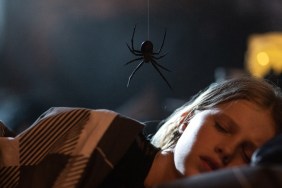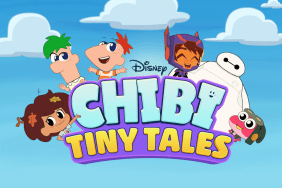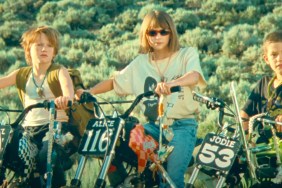
SHOCK rolls out 10 amazing horror movies that play with fairy tale conventions.
For centuries, fairy tales have served as a way to teach children right from wrong. Fables of kids outsmarting witches, besting giants, and being wary of mermaids have been filtered down for centuries, spreading by print or word of mouth through generations across the globe. These fantastical recollections of imaginative stories have not only served as inspiration for creative minds, but also relayed moral relativism through clever anecdotes, proving that a better world is possible if humans can just treat each other with the same decency as the characters in their books. Above all else, fairy tales offer escapism, and allow growing minds to dream of faraway lands where everything is beautiful, creatures are kind, and heroes always win in the end.
But why should fairy tales be relegated only to children? Why should adults be made to feel that theres a certain point in their lives where they are deemed to old to enjoy fantasy? The truth is, no one is ever too old to get in touch with the childlike innocence that once defined them, and no one is ever too wise to keep learning. Whereas short stories and ancient legends told at bedtime were once the method for spreading the history of these charming collections, now, grown ups can enjoy dabbling in the mysticism as well, through the magic of cinema.
With THE HUNTSMAN: WINTER’S WAR hitting theaters, and dozens of fantasy films and shows aimed towards older audiences on the horizon, such as BEAUTY AND THE BEAST, DUMBO, CRUELLA, THE LITTLE MERMAID, and the newly announced THE JUNGLE BOOK 2, what better time to look at some great dark fairy tale thrillers?

PANS LABYRINTH (EL LABERINTO DEL FAUNO)
Once upon a time, a little girl named Ofelia dared to imagine a world as magical as the one that existed in her books. Feeling suffocated by the madness around her, Ofelia often escaped into the safety of her fairy tales, where good and evil were easily distinguishable, and princesses wore pretty crowns, and never worried about things like war and tragedy. However, when her pregnant mother movies her right into the heart of falangist Spain by marrying a Captain of the Spanish army, Ofelia soon finds that her life is resembling more of a nightmare than a dream come true. Just when it seems that all hope is lost, she finds a faun in the labyrinth behind her new home, and unveils an ancient prophecy wherein she is the princess of an otherworldly realm. The faun promises her that she will be reunited with her real parents, the queen and king of the kingdom below, but she has to complete three tasks before she can regain her royalty. It seems like the perfect premise, but as Ofelia completes each task and sinks deeper into the world of pretend, her real life situation spins more out of control. Soon, shell have to choose, whether she wants to live in the present, or accept her path of the long lost queen of another time and place. Written and directed by Guillermo del Toro, PANS LABYRINTH is an essential fairy tale for grown ups. The film is breathtakingly gorgeous, and has the perfect blend of practical and digital effects that combine to create a very convincing dreamland. del Toros creatures are both stunning and terrifying (especially the Pale Man), which helps flourish the debate of whether theyre actually there to help Ofelia, or if theyre trying to trick her, or if theyre even real. Aesthetics aside, the thing that really stands out about this movie is its ability to reach its viewers on an emotional level. Ofelia speaks to the little kid in all of us, the one that was forced to grow up too fast, and learn that life, unlike folklore, doesnt always have a happy ending.

THE HALLOW
After making the big move from England to Ireland, brand new parents Adam and Claire Hitchens are excited for a chance of pace, in their new home in a remote old mill house up in the Irish woods. The locals arent pleased with the fact that the Hitchens have chosen to move into this particular area, and many caution them that those grounds belong to The Hallow, repeatedly saying the phrase If you trespass upon them, they will trespass upon you. The couple, of course, laughs off these warnings as nothing more than superstition spurred by ancient traditions, but as the beasts in the woods begin to make themselves known, theyll wish they had taken the frightened old townies at their word. This is the directorial debut for Corin Hardy, a man who has already won several awards for his short films, and grew up with an obsession with sculpting and animation, which explains why the woodland creatures in his film are so spellbinding and effective. The scares start early in this picture and dont let up until the end credits roll, making it not only a refreshing new take on sinister folklore on film, but also, a newer horror movie thats actually capable of scaring jaded audiences who have grown accustomed to the usual formulas.

LEGEND
An underrated gem from director Ridley Scott, LEGEND is one of the beautiful and fully realized fairy tales ever brought to the screen. Filled to the brim with glitter, rose petals, unicorns, goblins, and sweet merry song, its astounding that this film wasnt more popular when it was released back in 1985. Fortunately, since then, its gathered a cult following of people who appreciate it for what it really is: an incendiary example of how a film can lift its viewers out of their seats and take them on an enchanted journey to another world. Starting out simply as a tale of an innocent princess named Lily who goes exploring with the boy she loves, a forest dweller named Jack, their lighthearted romance is put to the test when the universe around them undergoes a chilling transformation. First, Jack shows Lily a rare sight deep within the woods: two white unicorns frolicking happily in the water. Jack warns Lily that it is forbidden to touch the stallions, but she cant help but reach for one when it draws near. As soon as she makes contact, a goblin lurking in the trees shoots the horse with a dart full of poison, chases it down, and cuts off its horn. Lily tries to coax a worried Jack by playing a game, and tosses her ring into a nearby pond, saying she will marry whoever finds it. Jack dives in immediately, but doesnt catch the ring in time, as it is then picked up by the beast beneath, known as the Lord of Darkness. Suddenly, the lively wonderland Lily once knew is overtaken by ice and snow, the sun is snuffed out, and the wildlife begins to wither and die. The goblin carries the amputated horn back to the underground realm where is claimed by Darkness, but a frightened Lily, who overheard the goblin bragging about its power, follows him down into the black pit. Caught and claimed by Darkness, who lies in wait, Lily has now become the queen of the underworld, and is forced to reign at the side of this hell beast for all of eternity. Her light, just like the worlds, has been stolen by the creatures down below, and both will be extinguished forever unless Jack and his newfound friends can retrieve the horn of the unicorn, and return it to its rightful place. Overflowing with imaginative sorcery and mystical energy, LEGEND serves as a reminder that even the darkest, most jaded spirits crave love, and that just because a movie is made for grown ups doesnt mean it cant contain wonder and awe.

SUSPIRIA
The first part of legendary giallo director Dario Argentos Three Mothers trilogy, SUSPIRIA is actually greatly inspired by the 1937 film, SNOW WHITE AND THE SEVEN DWARVES. Argento himself has said in interviews that visually, he took many cues from Walt Disneys iconic fairy tale, which places a much greater importance on the overly saturated and dreamy aesthetics rather than the plot. Although Argento admits to ranking style over substance, its hard to blame him, when the result is a film as magnificent as this one. Starring Jessica Harper as Susy Banyon, the American girl in over her head at a prestigious German ballet school, the story begins shortly before Susys arrival as the students at the academy begin mysteriously being taken out one by one. Susys new friend Sara suspects that there is witchcraft afoot, but it isnt until Sara herself goes missing that Susy decides to conduct her own investigation of the premises. The search starts innocently enough, but when Susy starts poking holes in the teachers claims and finding secret passageways hidden in the school walls, she realizes that a coven isnt out of the question.

VALERIE AND HER WEEK OF WONDERS (VALERIE A TYDEN DIVU)
Trippy, surreal, and growing stranger by the minute, VALERIE AND HER WEEK OF WONDERS is not to be missed. An unhinged and fantastical tumble down the rabbit hole, this 1970s experimental film from the Czech Republic is radical, even by todays standards. Starring an incredible fourteen year-old Jaroslava Schallerova as Valerie, the girl who got lost on her way back from Wonderland, it is inspired not only by Lewis Carrolls classic, but Little Red Riding Hood, as well. In the film, a young girl named Valerie who lives alone with her conservative grandmother has just gotten her very first period. As she transitions from being a child to becoming a woman, she starts to notice that people are behaving differently around her. Once overlooked like a weed in the grass, now she shines brightly in a crowded room; a blossoming flower not yet ready to be picked. Although this newfound attention is flattering, it also comes with its threats from cowardly men who wish to conquer her and steal her innocence. Valerie is learning that shes not a little girl anymore, and that entering womanhood can be just as confusing and frightening as it is wondrous and blissful. On her path to being an adult, Valerie will go up against priests, vampires, witches, virgins, thieves, angry mobs, and long lost family. Will she be able to overcome the trials and tribulations of puberty and evolve into a self-reliant young woman? The journey forth remains shrouded in mystery, but one things for sure: after this bizarre metaphorical odyssey into maturity is complete, Valerie will never be the same.

THE FALL
In the quiet hum of 1920s Los Angeles, in a bleak hospital bed inside the desolate building, lies a man so desperate for a quick fix to soothe his pain over losing his beloved, hes willing to tell a child recollections of fairy tales in exchange for the favor of bringing him his medicine, a.k.a. stolen morphine from the locked up cabinet. The childs name is Alexandria, and she loves to listen to the man, Roy Walker, speak for hours about the legendary ragtag team of five misfits who banded together to take down the dreaded Governor Odious: an explosives expert, an Indian, an ex slave, Charles Darwin, and a masked bandit, all putting aside their differences to conquer a greater evil. Too bad Roy cant conquer his demons. Set on putting himself out of his misery, he repeatedly purposely takes too many pills, hoping to leave his harsh reality and join his imaginary friends in an eternal dreamland. However, through his friendship with little Alexandria, Roy watches himself getting in touch with his humanity, and finding the will to live again. An epic feat by THE CELL director Tarsem, the costumes, set pieces, filming locations, and imaginative storytelling all combine to create a truly breathtaking and magical fantasy film that can be shared with children as well as adults. An awesome visual journey, THE FALL reminds film fans everywhere that if you can dream it, you can put it on the screen.

HARD CANDY
If the Grimm Brothers The Little Red Riding Hood had ended with the girl knocking the wolf over the head with her basket of food, tying him up and torturing him, it would be HARD CANDY. In the film, Hayley Stark (Ellen Page) chats with an older man online named Jeff Kohlver (Patrick Wilson) for weeks before meeting him in person at a coffee shop. After some shy flirting, fourteen year-old Hayley suggests to Jeff, the man old enough to be her father, that they go back to his place. The two then head to his house, where Hayley promptly seduces, drugs, and binds Jeff. When he wakes up, Hayley reveals that she has been watching him, that she knows he is a pedophile, and that she now demands a confession. Jeff says he doesnt know what shes talking about, almost like he forgot his crimes, but never fear. Hayleys brought a goodie basket full of vicious little toys and trinkets that are sure to make him remember. Directed by David Slade, the man who went on to define the high art look of beautifully shot HANNIBAL, this story about the prey turning the tables on the predator actually made an accidental allusion to the popular fairy tale. According to Slades commentary, the reason why Hayley wears the red hooded jacket in the film is because they had a very small budget and needed a bright color that would stand out against the scenery. It wasnt until foreign film markets like Japan got ahold of HARD CANDY and advertised it as a Little Red Riding Hood homage that the idea caught on, and people started thinking of the little revenge flick as a warped version of the beloved folklore. Some people were so inspired by the analogy that they even made a movement called SURF SAFE, WEAR RED, which called on people to wear red hoodies in order to send a message about standing up to online harassment.

BIG BAD WOLVES (MI MEFAHED MEZEEV HARA)
In the original Grimm Brothers Little Red Riding Hood (an adaptation of an even older 1600s European tale), a naïve young girl takes a basket of food to her sick grandmother, traveling by foot down a shadowy path in the woods. Her mother warns her not to talk to strangers, but when a curious wolf hops out of the trees and begins questioning her, little Red caves into her sweet nature, and offers up her plans. The wolf, cunning as he is, beats the girl to her to the house, eats the grandmother, and puts on her clothes. When the girl appears, the wolf tricks her just long enough into believing that he is her grandmother to open up his jaws wide and swallow her whole. Just like the Grimm folktale, its hard to tell which character in the 2013 Israeli thriller is actually a wolf in sheeps clothing. With a father set out for revenge, a crooked cop working outside of the law, and a religious schoolteacher accused of committing a horrifying act, only time will tell who is telling the truth, and who preyed upon the young girl in the woods. Filmmaking duo Aharon Keshales and Navot Papushados follow up to their 2010 festival hit RABIES, BIG BAD WOLVES is a master class in tension. It isnt just that its a well acted story that keeps the audience on its toes, it also sparks a deeply intelligent discussion about ones morality, and whether or not vengeance is ever justified, if it means becoming a monster.

NIGHTBREED (THE DIRECTORS CUT)
Midian is where the monsters live at least, thats the truth according to Aaron Boones dreams. Hes been seeing strange sights every night in his sleep, which feel so real, they seem more like premonitions than a made up part of his recurring nightmare. Following the advice of his girlfriend Lori, Boone begins seeing a psychiatrist named Dr. Phillip Decker. Little does he know, Decker has a few twisted images bouncing around in his own brain mainly consisting of murder. It turns out, Dr. Decker is an insane serial killer in need of a patsy to get the heat off of his back, and Boone walked through his office door in just the nick of time. Wrongfully accused in the witch hunt for a murderer, a terrified Boone takes off to escape his persecutors, and finally find Midian, once and for all. What he finds is a labyrinth of disfigured monsters tucked away beneath the ground; a little city for misunderstood misfits buried deep beneath the surface of a local graveyard. Boone feels safe and accepted by these creatures, but when the local townspeople discover their secret sanctuary, a war is soon waged between those who call themselves Nightbreed, and those who dare to call themselves human. Originally released in 1990, Clive Barkers NIGHTBREED wasnt received very positively by critics and audiences at the time, because the studio behind the movie edited the film into a completely different story than the director intended. Unable to accept the fact that the monsters were the heroes, the company ruined the project, and Barkers true vision wasnt seen until about twenty-five years later when he finally got to unleash his directors cut. Cleaned up and recut to include around forty minutes of new footage, Barkers original concept can now finally be seen and appreciated for what it is really meant to be: a a grown up fairy tale commentary on how the real monsters are the humans, and the victims are the ones hiding out in Midian, just hoping not to be hunted down by the society that damns them to the shadows.

THE RED SHOES (BUNHONGSIN)
Originally written as a Hans Christian Anderson fairy tale in 1845, THE RED SHOES tells the story of a peasant girl named Karen who is adopted by a wealthy woman and becomes extremely spoiled. When the nice red shoes her guardian gave her begin moving by themselves on Karens feet, she is fearful, but continues to wear them because she can take them off when she wants to. However, when she attends a dance in the midst of her adoptive mothers illness, Karen finds that the shoes not only wont come off, but, to her horror, they wont stop dancing, either. Condemned to a life of constant rhythmic motion, Karen cant even go to her adoptive mothers funeral for fear of literally dancing on her grave. She eventually has an executioner cut her feet off, but the shoes continue to dance, bloody stumps still caught within their ruby grasp. In 2005, South Korean director Yong-gyun Kim decided to try his hand at adapting the influential story, and came up with a terrifying twist on the old legend. In the film, a mother struggles to raise her only daughter after separating from her cheating husband, and moving out on her own. One day, the woman finds a pair of blushing pink heels on the subway, and, unable to spot an owner, snatches them up and takes them home. The shoes are lovely, and help her to win the affections of a certain handsome interior designer, but they seem to have an odd effect on the women in her life, from her daughter stealing and hiding the shoes in her room, to her best friend walking out of her apartment wearing them and mysteriously dying on her trek back home. With her loved ones lives at stake, the woman attempts to rid herself of the lively footwear, but only finds them reappearing in her house over and over again. This is a curse that wont be absolved with a simple disposal. Just as it was revealed in Hans Christian Andersons original text, the price for vanity is an ongoing punishment, that exists long after a person is gone.









